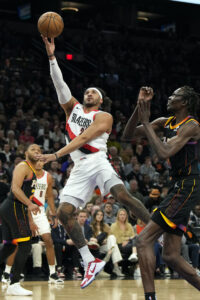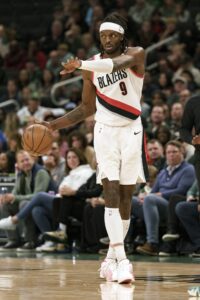As our list of traded 2024 first-round picks shows, 14 teams have dealt their first-rounders in next year’s draft (either with protections or without) and another two clubs have surrendered swap rights to their picks. That means over half of 2024’s first-rounders could theoretically be changing hands, with more potentially on the move as a result of in-season trades.
In actuality, due to protections on several of those traded picks or the fact that certain swap rights won’t be exercised, several of the first-rounders that could change hands won’t do so. It’s still too early to say with certainty which picks will be on the move and which will stay put, but with the NBA season past the one-third mark, we’re starting to get a clearer picture.
Here’s an early look at the traded 2024 first-round picks:
Picks that will change hands
- Nets‘ pick (unprotected) to Rockets
- Lakers‘ pick (unprotected) to Pelicans
- Clippers‘ pick (unprotected) to Thunder
These three picks don’t include any protections, meaning it’s a lock they’ll change hands. The only source of drama is where exactly they’ll land.
The Brooklyn pick looks like the best asset of the three — the Nets are currently tied for the 11th-worst record in the NBA, which means their pick would be in the lottery unless they earn a playoff spot via the play-in tournament.
The Lakers, currently eighth in the West, have the NBA’s 16th-best record, so their pick would come in around No. 15, though that could move in either direction if they end up in play-in territory. It’s also worth noting that the Pelicans have the option of deferring that pick to 2025 — if it stays around the middle of the first round, I expect New Orleans would have a hard time passing on it.
The Clippers are tied for the NBA’s eighth-best record, so their first-rounder would be at either No. 22 or 23 if the season ended today.
- A Thunder pick (conditional) to Pacers
The Thunder owe the least favorable of their four first-round picks to Indiana, so it’s a sure thing that the Pacers will get a pick from Oklahoma City — we’ll just have to wait to find out which one it’ll be.
That group of first-rounders controlled by the Thunder includes their own selection, the Clippers’ pick (unprotected), the Rockets’ pick (top-four protected), and the Jazz’s pick (top-10 protected). If the season ended today, the Pacers would receive OKC’s own first-rounder at No. 25.
Picks expected to be protected
- Pistons‘ pick (top-18 protected) to Knicks
While it’s not technically official yet, there’s no viable scenario in which the 2-29 Pistons will give up their first-round pick this season. They’ll keep that selection and will instead owe New York their 2025 first-rounder with top-13 protection. Based on how Detroit has looked this season, the Knicks probably won’t be holding their breath to get that pick before at least 2026 (when it’s top-11 protected) or 2027 (top-nine protected).
- Wizards‘ pick (top-12 protected) to Knicks
- Hornets‘ pick (top-14 protected) to Spurs
- Trail Blazers‘ pick (top-14 protected) to Bulls
The Wizards, Hornets, and Trail Blazers haven’t been quite as bad as Detroit, but they’re each among the NBA’s bottom five teams so far and have shown little indication that a play-in push is around the corner.
Barring a huge surprise, the Wizards will keep their 2024 pick and owe the Knicks their top-10 protected first-rounder in 2025; the Hornets will keep their 2024 selection and owe San Antonio their top-14 protected first-rounder in 2025; and the Blazers will hang onto their pick in 2024 and owe Chicago their lottery-protected first-rounder in 2025.
Picks still up in the air
- Raptors‘ pick (top-six protected) to Spurs
Toronto is tied for the seventh-worst record in the NBA right now, so the pick the Raptors owe to San Antonio could turn out to be a worst-case scenario for them by landing at No. 7 or No. 8. If the Raptors end up not making the playoffs, they’ll be rooting hard to move up into the top four on lottery night.
- Jazz‘s pick (top-10 protected) to Thunder
The Jazz are currently the ninth-worst team in the league. If they finish the season that way, they’d hang onto their pick unless two teams below them in the lottery standings leapfrog them. It will be interesting to see how aggressively the front office sells off pieces this season in an effort to keep that first-rounder — or whether that will even be necessary.
- Warriors‘ pick (top-four protected) to Trail Blazers
- Rockets‘ pick (top-four protected) to Thunder
- Mavericks‘ pick (top-10 protected) to Knicks
- Kings‘ pick (top-14 protected) to Hawks
In all likelihood, the Houston, Golden State, Dallas, and Sacramento picks will change hands, but it’s not a lock yet. If the Warriors (currently at No. 11 or 12 in the draft order) and Rockets (No. 14) end up in the lottery, there’s always a chance they could jump into the top four.
The Mavs and Kings, meanwhile, look like probable playoff teams, but there are a lot of contenders in the West, so if those teams don’t secure a top-six seed, anything could happen in the play-in tournament. For now, Sacramento and Dallas hold the fifth and sixth seeds in the Western Conference standings.
- Suns‘ swap rights to Wizards or Grizzlies
- Bucks‘ swap rights to Pelicans
Assuming they keep their top-12 protected pick, which is a safe bet, the Wizards would have the opportunity to swap first-rounders with the Suns. And if Washington passes on that chance, the Grizzlies would get the same opportunity.
It’s hard to imagine a scenario in which the Wizards will get to exercise that right, and I would’ve said the same thing about Memphis a week or two ago. Suddenly though, the gap in the standings between the Suns (15-15) and Grizzlies (10-20) doesn’t look insurmountable — it’s not entirely out of the question that Memphis will catch Phoenix and take advantage of the chance to swap first-rounders.
The gap between the Suns and Grizzlies is actually smaller than the one between the 23-8 Bucks and the 18-14 Pelicans. While we can’t rule it out yet, it seems unlikely that New Orleans will surpass Milwaukee in the standings and get to use the ability to swap picks with the Bucks.


 Each player’s cap hit is noted here. The team would no longer be on the hook for that cap charge if a player is claimed off waivers.
Each player’s cap hit is noted here. The team would no longer be on the hook for that cap charge if a player is claimed off waivers.

 January 10 is the date that all
January 10 is the date that all  A significant portion of the NBA’s offseason signees became eligible to be traded
A significant portion of the NBA’s offseason signees became eligible to be traded